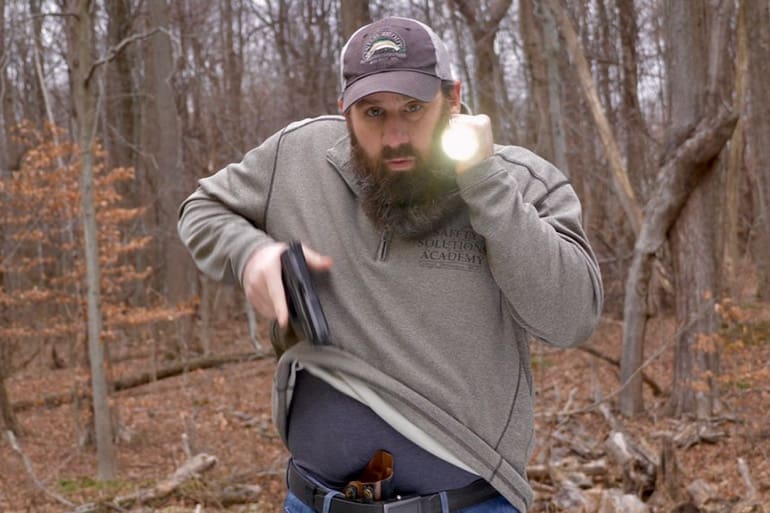
A how-to from The Mag Life, official publication of GunMag Warehouse
By Paul Carlson
Everyone wants more speed, especially when it comes to concealed carry and the first shot. There are a lot of reasons to work on increasing your draw speed and lots of ways to do it. One area that seems to get less attention than it deserves is everything that comes before the gun is actually drawn from the holster. When it comes to draw speed, the movements before you actually draw take longer than any other part of the draw.
That’s right, the amount of time it takes to clear your cover garment and get a grip on the gun is more than any other part of the draw. If we focus on making these parts of the draw more efficient we can make a significant improvement in our draw speed. If you want a faster first shot time, read on for some tips for a faster concealed-carry draw.
Clear the Garment
When it comes to a fast draw from concealment, an important part of the draw is clearing your cover garment. Your garment is an important part of concealing your handgun, but you have to accept that the garment needs to be cleared prior to the draw and this takes time. Being proficient at clearing your garment can be one of the most important aspects of drawing your gun and increasing your draw speed.
Types of Cover Garments
In a perfect world, we would all have the freedom to select the cover garment that concealed our gun well and also provided easy access. Our world is far from perfect. Often times outside influences determine what we conceal and how we conceal our defensive tools. It makes sense to know our options and how to deal with them.

Open-Front
From sport coats to winter coats and even an unbuttoned shirt, open front garments are a popular choice for folks that carry concealed.
When Open-Front Cover Garments Work
An open-front garment is best for those carrying strong side or behind the hip. In cooler weather or in situations where a sport coat is appropriate attire, open-front is a popular option. Some folks who carry outside the waistband in warmer climates use an open button-up shirt as their cover garment.
Clearing Your Cover Garment: Open Front
Clearing an open-front cover garment isn’t without its challenges, but it can be a bit simpler than dealing with closed-front garments. First off, with an open-front garment, there is more freedom of movement.

Since your shirt or coat is open you have the ability to move it farther out of the way and you should take advantage of that. This will help to prevent your cover garment from contaminating your grip and fouling your draw.

On the other side of the coin, clearing your open front shirt or coat tends to be a one-handed affair. Even if you have two hands available, your support hand is generally out of reach. The best your secondary hand can do is pull on the offside of your garment to help move the strong side to the rear. This leaves your strong hand wanting to do two things at once. You need to resist the urge to grasp the gun too quickly. Instead, clear the garment THEN grasp the gun.
How to Clear Your Open Front Cover Garment
When you recognize a threat and the need to draw your gun, hook the strong side edge of your cover garment with your fingertips or your thumb. Sweep the material well behind your handgun. After clearing the garment drive the hand forward and down onto the back strap of the gun.

Tip
The lighter the weight of the material the more difficult this technique is. It relies on the momentum of the material to continue the motion to the rear. Competitive shooters who are itching for a fast draw have been known to sew weights onto the bottom edge of open-front cover garments to help clear the garment. If you are wearing a lightweight open-front shirt, sewing a penny in the bottom corner of your shirt may be just the ticket.
Closed-Front
Because I routinely carry in the Appendix Inside the Waist Band (AIWB) position (think 1 o’clock) I consistently cover my concealed carry handgun with a closed-front garment. With a closed-front garment, I gain the ability to carry in front of the hip and can maximize my wardrobe options.

Closed-front garments aren’t just for AIWB guys, it can work for strong side carry and even behind the hip as well. There are situations where I am forced to wear my closed-front garment tucked which changes the game a touch, but we will save that for a separate post to deal with the specifics of tucking a shirt for concealment.

How to Clear Your Closed-Front Cover Garment
There are many methods for clearing a closed-front garment but the most reliable method is an aggressive grasp. Some folks like to drag their fingertips or thumb to hook the hem, and these techniques can work, but an aggressive grasp increases the likelihood of clearing the cover garment.
Aggressive Grasp
Depending on the style and fabric of your shirt you may find that firmly grasping the garment just above the grip of the gun may be the most reliable way to clear your cover. Closing your fingers on the fabric, ripping out high and out of the way and then releasing it is likely to take more time than simply hooking the thumb or dragging the fingers. The extra fraction of a second is probably worth it because it is a more reliable method of clearing your concealment garment. A deliberate grasp executed to completion will beat a fast finger or thumb drag that misses your cover every time.

As with all defensive skills, it makes sense to invest time testing your plan in both live-fire and in force-on-force training.
Tip:
If you are drawing strong-side with a closed-front garment your support hand probably isn’t much help, but let’s face it, in a real defensive encounter your support hand may be busy doing something else. You could be holding a light, pushing a loved one away, or grasping and controlling an attacker. Even if you carry in a position where two hands can assist your draw (like AIWB) you better have solid skills drawing with one hand! That means clearing your cover garment and then drawing with your primary hand only.


Final Thoughts
The ideas we looked at in this brief examination of how to increase your draw speed through a more efficient clearing of the cover garment doesn’t just apply to guns. It is just as applicable to blades, lights, spray, or even that spare mag. I carry a second mag at the 11:30 position on my belt. I use the same skills for clearing the cover garment to draw my S&W M&P 9mm mag as I do for the handgun itself.
When it comes to drawing a gun to defend yourself and those that you love, there is no doubt that it is a complicated task. There are mental and decision-making aspects to deal with and there are the obvious technical skills involved. With persistent quality practice, you can remove concerns about clearing your cover garment from the equation and focus your attention and energy on other aspects of self-defense where you have less control.
Paul Carlson (@paul_carlson_ssa) is a longtime contributor to The Mag Life, a firearms instructor with Safety Solutions Academy(q.v.), and guest host on GunMag TV.




